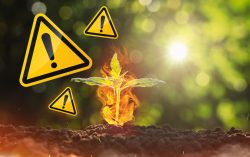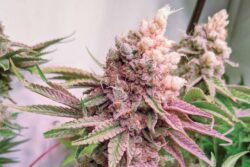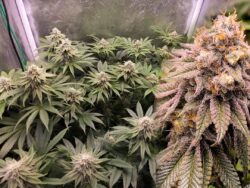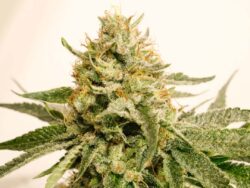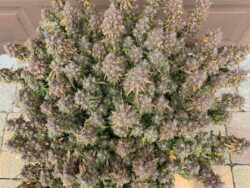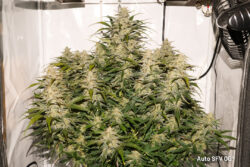Watering cannabis plants how-to guide

Watering cannabis ought to sound like it’s one of the simplest things to get right in your grow room. However, after several decades specialising in cannabis seeds, Dutch Passion have found that over-watering (and over-feeding) cannabis plants is one of the most frequent problems seen in the grow room especially by less experienced growers. In simple terms cannabis roots will not grow well in waterlogged soil conditions due to lack of oxygen.
If the cannabis roots can’t grow healthily then nor can the rest of the plant. Everything from mineral/nutrient uptake to respiration is affected and in the worst cases growth can stop and plant damage can be terminal. The flawed, but perhaps partially understandable logic from the less experienced cannabis grower is that more water/nutrients will result in larger cannabis plants.
In fact the largest, healthiest cannabis plants can only reach their full genetic potential/potency if they are neither overwatered nor over-fed. This is equally true whether growing autoflowering cannabis seeds or feminised seeds, the same principles apply. Read on for some expert tips and advice on how to water your cannabis plants and avoid the pitfalls of under-watering and over-watering your cannabis plants.

The basics of watering cannabis plants
One of the difficulties with watering cannabis plants is that it is far from a precise science. Larger cannabis plants need more water than smaller plants. The amount of watering required will be affected by ambient temperatures and humidity as well as the type of grow method, the age of your plant and other factors such as the plant container size. An expert grower will have the practical experience to process all the variables and know the right amount of water to provide at any given point in the cannabis plant life cycle. For the rest of us, useful hands-on tips and advice can mean the difference between a successful harvest and a poor one compromised through over watering.
Under watering symptoms and cure
Under watered cannabis will often have wilting leaves and a drooping, lifeless appearance. The leaves will hang downwards with a limp appearance. The experienced grower won’t confuse the symptoms of overwatering (clawed leaves, described below) with under watered cannabis.
One other clue to diagnosing under-watered cannabis is to take a quick look at the grow medium. If you’re grow cannabis in soil which feels bone dry it’s a sure sign that the cannabis roots have very little available moisture. Fan leaves may also show some brown or yellow discolouration when under-watered. The simple solution is to water your cannabis plants.

Useful tips for under-watered cannabis plants
Ensure even application of water
When applying water, it is important to cover the surface area of the grow medium with equal amounts of water. Don’t just water the centre of the grow container, water the edges equally as well. A watering can with a sprinkler will give more equal watering than dumping all the water onto a small central area of your container. Apply the water slowly, allowing even application. This also avoids damaging and disturbing the sub-soil root structure if all the water is suddenly tipped onto a small area of the surface.
Monitor the weight of your plant container to assess when to water
One other useful tip is for growers to monitor the weight of their plant container when wet and dry. This can provide a useful future guide for when the plant needs watering. Monitoring the weight of your plant container can help prevent the less experienced grower from routinely over-watering their cannabis plants.
Use a hygrometer
A hygrometer is a device with a probe that is inserted into your grow container. Hygrometers are popular with soil growers since they provide a clear reading of sub-surface water/moisture levels. They are available from companies such as Blumat. Many growers, including highly experienced master growers as well as rookies, will have a hygrometer in each grow container to give an ongoing moisture readout.
A hygrometer removes all the guesswork from watering and is recommended to any grower that has struggled with cannabis plant watering. This is a useful tool to prevent growers routinely over watering their cannabis plants, one of the most common grower mistakes, especially by less experienced growers.
Under-watering is generally less damaging to cannabis than over-watering
One useful tip, especially for less experienced growers is to err on the side of under-watering your plants. This is less troublesome than permanently over-watering your plants and leaving the roots in a continuously waterlogged state. Cannabis plants grown in waterlogged soil are often permanently stunted and never reach their full potential.
Over watering symptoms and cure

Over watered cannabis will often have leaves that appear to have a healthy green colour. The cannabis leaves tend to claw inwards, rather than displaying the limp and wilted appearance of an under watered plant. A quick check of the grow medium is also a good way to determine if your plants have been overwatered.
Typically, the grow medium will be excessively wet with more moisture than the cannabis roots require. At the same time, the grow medium may also be poorly oxygenated which compounds the problems and the slow rates of growth. In the worst cases, a chronically over-watered cannabis plants is permanently stunted and never reaches anywhere near her full genetic potential.
After many years supplying cannabis seeds to home growers and professional growers, it is clear that many growers tend to regularly over-water their plants and compromise final harvest quality/quantity as a result.
Useful tips for over-watered cannabis plants
Avoid leaving your cannabis plants sitting in run-off water
Leaving your plants sitting in run-off water is generally considered poor grow room practice. Run-off water quickly becomes stale and can be a breeding ground for bacteria, mold and pests. Pour it away or soak it up with a sponge and dispose of it.
Check your grow medium is draining correctly
If you grow in a good brand of light soil or coco fibre (which has a naturally highly aerated structure) it’s unlikely that you will have any drainage issues. But less experienced growers using e.g. a home-made soil blend may find poor drainage properties can result in their plant roots sitting in waterlogged conditions.
If it takes several minutes for water to stop flowing after a good watering, it could be a sign that your mixture is too heavy. Be sure to use a more aerated grow medium in future grows, perhaps with added perlite or coco fibre. Use of air pots of fabric grow sacks is another way to increase oxygenation levels in the root zone. But these should be used in conjunction with an aerated grow medium, rather than in place of an aerated grow medium.
Related:
Cannabis roots, all you need to know
Remember that cannabis plants grow at different speeds
Some cannabis strains, as well as individual phenotypes, will grow at their own pace. This may be a result of the genetics or a response to grow conditions. In cool conditions, clones of the same strain can grow at quite different speeds to those in optimised conditions. The experienced cannabis grower will understand and allow for the subtle changes to plant appetite and will respond accordingly, being careful to avoid overwatering.
Evaluate your climate and act accordingly
A hot, dry low humidity environment will cause your plants to consume more water. In contrast, your plants would consume less water in a cooler higher humidity environment. It is therefore very important to keep a close eye on both your min/max temperature and humidity. You can adjust your watering amounts accordingly to allow the right amount of water for the corresponding conditions.
What type of water is best-suited for cannabis
Cannabis plants have coped well with rainwater for millennia. They are tough, adaptable, and hardy plants that can cope with a range of conditions and water types. Sometimes we must remind ourselves that cannabis grows very well without human supervision! But it’s always worth a quick look at the various water types and how they can affect cannabis cultivation.
Tap water for cannabis

Most growers use tap water for cannabis. The level of acidity/alkalinity is known as pH. This is usually a neutral pH value of 7, but it can vary from city to city and water supply to water supply. Soil growers rarely worry too much about pH since soil is a natural buffer. But those growing cannabis hydroponically (or in coco fibre) will check incoming water pH carefully with a calibrated pH meter and adjust to keep it around the pH5.6-5.8 area. At these optimised pH levels, all the minerals in water are bio-available for absorption. Outside of a useable pH, minerals may be difficult for the plant to easily absorb even if they are present. This is known as nutrient lockout.
Bottled water for cannabis

Some growers use their favoured supply of bottled water if they have reservations about the quality of the local tap water. Often, they feel that certain natural water springs deliver favourable mineral contents. But it’s an expensive way to water your plants. Cannabis growers that feel their tap water supply is too inconsistent often invest in a reverse osmosis system to purify their own water. Hydroponic cannabis growers often like to use reverse osmosis water to remove minerals from the incoming water supply. This allows them the ‘blank canvas’ of precisely controlling all the minerals which are subsequently introduced to their grow system
Water collection system

Some organic growers like to collect natural rainwater and use it for watering their cannabis plants. The logic is that the water will be free of chlorine and other potential contaminants introduced during water treatment. The downside of using rainwater is that some consider it to be less pure than top water, especially when it has fallen in large industrial cities through a potentially dirty atmosphere. Some people are also concerned about possible biological impurities such as bugs, spores, or pest larvae.
Re-using clean water from the dehumidifier
Most growers use dehumidifiers to extract the moisture out of the air in order to keep a stable humidity level or ‘RH’. When cannabis plants grow, much of the liquid water that is given to them is returned to the atmosphere via transpiration (moisture release via the stomata on the leaves). You can use a dehumidifier to collect the water that was extracted from the air. This water can be re-used to water the plants again, perhaps alongside tap water. Note that dehumidified water contains less (or no) minerals compared to tap water.
Hand-watering vs auto-watering systems for cannabis

Both hand-watering and auto-watering systems for cannabis growing deliver great results when done well. Hand watering is often preferred by those seeking the simple approach, or perhaps those with just a few plants to care for.
Auto-watering systems can be the only practical and realistic option for those growing cannabis in commercial quantities such as legal, licensed growers. Whether hand-watering or auto-watering cannabis plants the same key principles apply. If growing in a grow medium such as soil, the cannabis roots need to be kept in the ‘goldilocks’ sweet spot where they are neither over-watered nor under-watered.
Those growing in hydroponics systems such as deep water culture (‘DWC’) won’t need to worry about over-watering. By definition, a good hydroponic grow system will have specialist attention given to deliberate oxygenation of the roots, perhaps with an air-stone or similar. For anyone unfamiliar with the technically challenging array of hydroponic grow options and how best to use them the following in-depth guide is essential reading.
Related:
The complete hydroponic cannabis growing guide
Cannabis stage-by-stage watering schedule
With so many different factors influencing the specific amount of water required by your plants it should be clear that watering your cannabis requires some skill if you are to grow your plant from cannabis seed to harvest without over-watering or under-watering. As your experience grows, your natural ability to gauge and assess water needs will improve. Weighing your plant container is one way to know how much water they contain.
A hygrometer is highly recommended to growers of all skill levels to know precisely how much moisture is available to the cannabis roots. The following guidelines may also help.
Cannabis seeds and water

It may seem strange to consider the water needs of cannabis seeds. But one of the main causes of poor germination rates is due to weed seeds being germinated in excessively wet conditions. If left for too long in soaking conditions (e.g. several days submerged in water) the newly emerged tap root can rot and die. After several decades supplying cannabis seeds the Dutch Passion team feel that the best way to germinate cannabis seeds is between two lightly sprayed/dampened cotton wool pads.
Related:
Best way to germinate cannabis seeds, lightly sprayed cotton wool pads
Watering cannabis seedlings

Cannabis seedlings require less water than at any other stage of their growth cycle. Water usage is low. The tiny leaves have minimal water transpiration rates. When watering seedlings recognise that water requirements are small. Problems often come from over-watering seedlings in soil which leaves roots unable to grow and stunts the plants. Cannabis seedlings can also be damaged if battered by a strong flow of water from a great height.
Related:
Top 10 germination and seedling mistakes
Watering cannabis during the vegetative stage

Water usage rates gradually increase during vegetive growth. Plants produce more leaves which all transpire. The cannabis root system also gradually increases in size allowing the plant to gather more water and nutrients as it grows and prepares for eventual bloom.
Related:
The cannabis vegetative stage how to guide
Watering cannabis during the flowering stage

Water requirements are highest during bloom. At this stage the plant has reached it’s maximum biomass. If you grew the best cannabis seeds you may have a large plant with numerous blooms and a tent-filling stature. Such plants can consume several litres of water/nutrients per day but will reward the attentive grower with heavy THC rich harvests.
Related:
The cannabis flowering stage how to guide
Cannabis plants watering FAQ
Watering your cannabis plants and avoiding over-watering/under-watering is more complicated than it may initially sound. Many growers struggle with watering, often over-watering grow after grow. As a result, they miss out on the best potency. But with a little practice and some useful tips (such as a hygrometer and/or weighing your grow containers to assess water needs) you will soon be able to overcome watering issues and see better plant growth as well as superior quality harvests.
At what time of the day should you water your cannabis plant?
The best watering frequency is that which delivers neither over-watering nor under-watering in your specific grow conditions. Many experienced growers will know the water needs of their plants in their grow system at various stages of growth. A large 2-metre-tall indoor plant of a particular strain, grown in coco fibre may need several litres of water/nutrients per day. Some growers prefer to deliver this liquid in several instalments throughout the day to avoid excessive drying out. However, this may not be practical for every grower who may just be able to water their plants once per day. The key principle is to ensure that your plants never dry out, nor should they be overwatered.
An automatic watering system that continuously drips nutrients is preferred by some people. Others would opt for something like the AutoPot system that gravity-feeds nutrients only when the grow medium has partially dried out. Cannabis will grow well with either approach and there are numerous different grow systems with varying approaches to watering and automation. These involve techniques such as flood and drain, drip feeding, timer-based watering systems and many others. Remember that the cannabis plant needs to avoid the stressful extremes of having permanently waterlogged roots as well as avoiding the near-death experience of wilting and drying out.
Related:
Top 5 cannabis strains for a hot and dry climates
What is the best water pH level range for cannabis?

When grown organically in soil, which naturally buffers pH, the pH of your incoming water supply is rarely an issue and many soil growers never check water pH. Connoisseur soil growers may choose to adjust pH to the soil-preferred pH range of 6.3-6.8. But most soil growers don’t bother. Those growing with other grow methods/grow mediums (e.g. coco or hydroponic growers) may well have to control water/nutrient pH nearer 5.6-5.8 to ensure that all minerals are bio-available to the cannabis roots. Cannabis nutrient lockout occurs if the wrong pH is used. With nutrient lockout, even if minerals are present, they cannot be absorbed if the pH is outside preferred limits.
How to check if the water is draining properly?

If growing in e.g. soil, coco fibre (or similar) check to see that water/nutrients run freely through your grow medium and collect in a pool of run-off at the bottom of your container within a minute or two. If you see slow run off it could be due to poor drainage. This can happen if the e.g. soil blend is too heavy. Addition of perlite, coco fibre or light mix soils could be methods of improving drainage.
How to remove runoff water after watering cannabis plants?
Some people collect the run-off water in a saucer or tray underneath their plant containers. This can be drained away by gravity or pumped away. If you have just a few plants you may find it easiest to pour the run-off away or ‘mop’ it up with a sponge by hand. Run-off water can contain minerals in the wrong concentrations/ratios for growth and is typically discarded. Stale run off is a potential breeding ground for pests, mold and bacteria and has no place in your grow room. Get rid of it quickly.
How to water cannabis plants when you are away?

Many growers actively avoid planning a vacation, even a short one, while they are growing. Others will arrange a friend to take care of their crop. Many find it difficult finding someone they can trust to care for their crop and rely on automated watering devices, such as Wilma or AutoPot systems, to water their plants while away.
Use of large grow sacks is another option for soil growers. If using a large (e.g. 75 litre) grow sack of soil a small cannabis plant may be able to survive a week or so without needing additional watering. However, larger cannabis plants will be less forgiving and will have greater water needs. Many grow shops sell specialist automatic watering devices, drip lines, pumps etc. If you plan to be away from your plants regularly it pays to plan ahead and buy/design a system that meets your needs and time availability.
Another useful safety tip for anyone worried about leaving their plants alone is to get a temperature activated fire extinguisher for their grow room. These automatically discharge if the grow room temperature exceeds a specified limit on the extinguisher. If growing with good quality equipment and legal electricity grow room fires are rarely heard of. But for the grower seeking maximum peace-of-mind while away from their plants, a temperature activated fire extinguisher may be useful.











